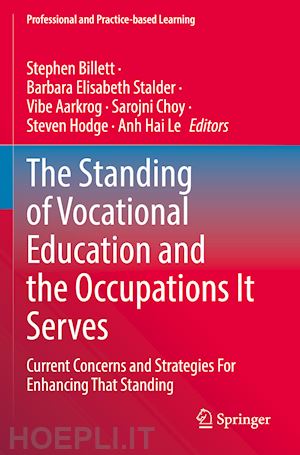

Questo prodotto usufruisce delle SPEDIZIONI GRATIS
selezionando l'opzione Corriere Veloce in fase di ordine.
Pagabile anche con Carta della cultura giovani e del merito, 18App Bonus Cultura e Carta del Docente
This book addresses what is, perhaps, the single most important issue for vocational education; its relatively low standing in an era of high aspiration. The work explores the nature, extent and consequences for an educational sector that whilst having an increasingly important role in contemporary societies is seen to be of low standing across both countries with developed and developing economies.
Some of the standing is associated with the occupation it serves and this is highlighted in an era of high aspiration by young people and their parents. The consequences are far-reaching. This includes how governments and community view and support vocational education, parents and familiars advise about participation in it and young people’s decision-making associated with their post-school pathways. More than describing this problem, the focus of this collection is how this issue can be redressed through the actions of supra-government agencies, governments, schools in tertiary education institutions, industry and professional bodies and employers. It sets out the quality and extent of societal sentiments in shaping how vocational education and the occupation it serves are projected, across countries, continents and cultures, and offers a range of perspectives and contributions from scholars on how this issue might be redressed. These contributions are drawn together and synthesised into sets of propositions, practices and approaches directed towards governments, schooling and tertiary education institutions, educators, researchers, industry and professional bodies and employers. In this way, the book seeks to provide an authoritative, seminal, comprehensive and central text to understand and respond to this central issue for vocational education.Barbara E. Stalder is Professor at the Institute of Upper Secondary Education, Bern University of Teacher Education, Switzerland. Her research interests are in in student engagement and learning, career development in vocational education and training, and career success over the life-course.
Vibe Aarkrog is an associate professor, Ph.D. of Vocational Pedagogy at the Danish School of Education, Aarhus University, Denmark. Her research concern pedagogical and curricula issues related to the interrelation of school-based and workplace-based learning in dual vocational education and training.
Sarojni Choy is a Professor of Adult and Vocational Education in the School of Education and Professional Studies, Griffith University. Her research interests are in vocational education and training, connecting educational experiences across different settings, continuing education and training, and workforce capacity building.
Steven Hodge is a Senior Lecturer in Adult and Vocational Educatoin in the School of Education and Professional Studies, Griffith University, Brisbane, Queensland Australia. His research is in the broad area of curriculum with particular interest in how curriculum is constructed, represented and interpreted.
Anh Hai Le is a lecturer and senior research assistant at Griffith University. Her research interest focuses on curriculum development in tertiary education, with a specific emphasis on the process of building knowledge through scholarly engagement with industry and higher education institutions.











Il sito utilizza cookie ed altri strumenti di tracciamento che raccolgono informazioni dal dispositivo dell’utente. Oltre ai cookie tecnici ed analitici aggregati, strettamente necessari per il funzionamento di questo sito web, previo consenso dell’utente possono essere installati cookie di profilazione e marketing e cookie dei social media. Cliccando su “Accetto tutti i cookie” saranno attivate tutte le categorie di cookie. Per accettare solo deterninate categorie di cookie, cliccare invece su “Impostazioni cookie”. Chiudendo il banner o continuando a navigare saranno installati solo cookie tecnici. Per maggiori dettagli, consultare la Cookie Policy.